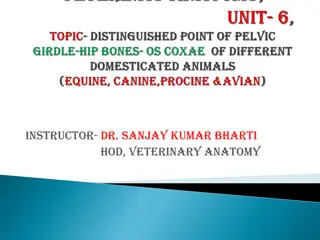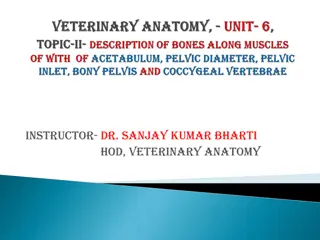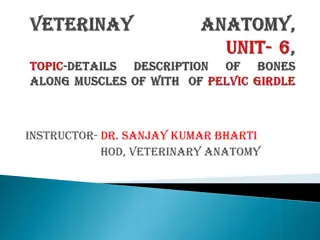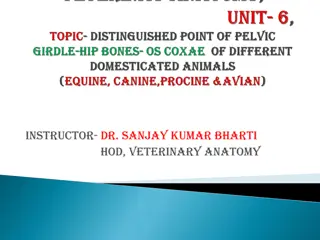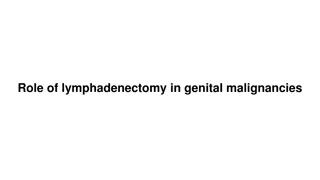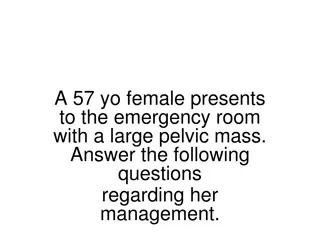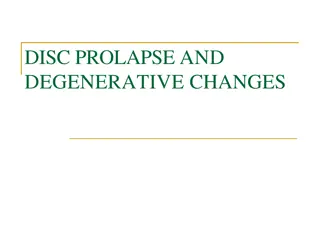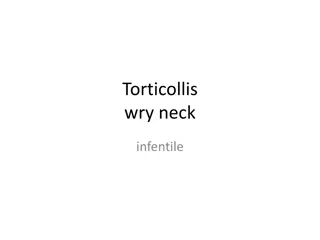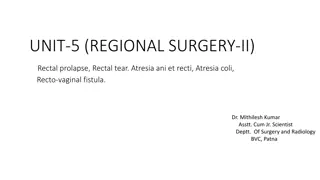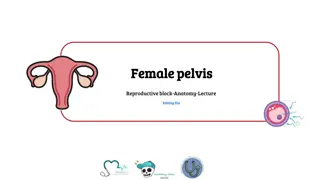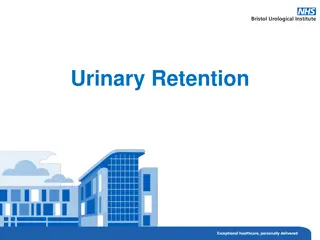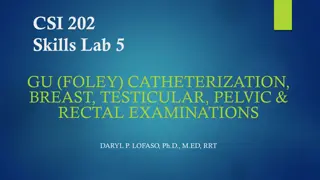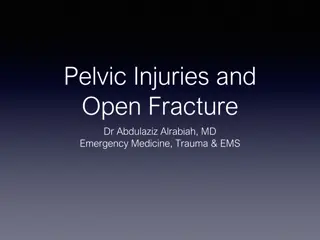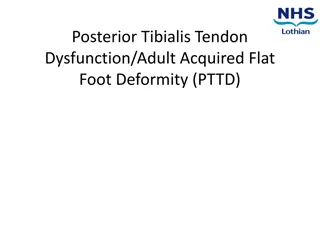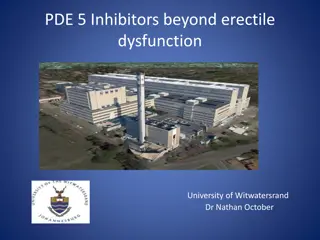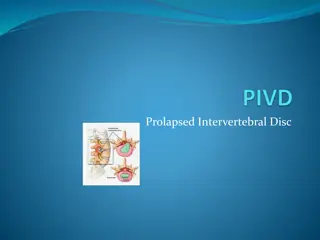Understanding Pelvic Floor Dysfunction and Prolapse in Women
Pelvic floor dysfunction and prolapse are common issues affecting women, impacting their physical and emotional well-being. Surgical treatment may be necessary for symptomatic cases, but a thorough evaluation of symptoms, obstetric history, and other factors is crucial. Addressing precipitating factors like chronic cough and constipation is important before considering surgery. Understanding the history of present complaints, obstetric history, and menstrual history is essential in determining appropriate treatment.
Download Presentation

Please find below an Image/Link to download the presentation.
The content on the website is provided AS IS for your information and personal use only. It may not be sold, licensed, or shared on other websites without obtaining consent from the author. Download presentation by click this link. If you encounter any issues during the download, it is possible that the publisher has removed the file from their server.
E N D
Presentation Transcript
UV PROLAPSE MODERATOR: COL P S RAO SR ADV (OBS GYN) GYNAE ONCOLOGIST AND ROBOTIC SURGEON
INTRODUCTION Increased lifespan of women, the problems of pelvic floor dysfunction are increasing Significantly impair physical functioning, emotional well-being and the quality of life The lifetime risk of undergoing surgery for prolapse or urinary incontinence 11% Evaluation of women should focus on specific symptoms and the degree to which they affect quality of life Definitive treatment of prolapse is surgery but should be performed only if symptomatic If prolapse incidental or symptoms not attributable, operation deferred
DETAILS IN HISTORY History of presenting complaints: Duration of prolapse Rate of increase in severity Bladder and bowel complaints Irreducibility of prolapse indicates longstanding nature of the problem Congestion Edema Hypertrophy of the tissues
DETAILS IN HISTORY History of precipitating factors Chronic cough Constipation Abdominal swelling (They need to taken care of before surgical treatment is instituted so as to reduce risk of recurrence) Obstetric history: Birth injury Postmenopausal tissue atrophy
DETAILS IN HISTORY Obstetric history:- Pregnancies at short intervals Prolonged labour Big babies Lack of perineal exercises Parity of the patient Desire to preserve fertility
DETAILS IN HISTORY Menstrual history Postmenopausal state should be noted as deficiency of estrogen around menopause Results in weakening of connective tissue and aggravation of prolapse Associated menstrual abnormality may need further evaluation and may modify choice of treatment
DETAILS IN HISTORY Other symptoms White discharge, Metrorrhagia Post coital bleeding may be due to decubitus ulcer Assess the urinary tract, defecatory or sexual dysfunction History of any other associated problems Treatment History Any treatment in past especially in form of pessary or surgery and its results
WHAT ARE THE COMMON URINARY SYMPTOMS IN PROLAPSE AND THEIR MECHANISM? The woman with prolapse may present with Difficulty in initiating micturition is common problem in women with large cystocele Difficult to empty the bladder Difficulty increases with straining as bladder base and trigone descend Empty the bladder only after reducing the mass digitally Frequency and dysuria Incomplete emptying of bladder leads to increased risk of cystitis Stress urinary incontinence may be present if prolapse is associated with descent of urethra vesical junction Rarely retention of urine below the level of urethra
WHAT IMPORTANT POINTS WILL YOU NOTE IN EXAMINATION OF THIS WOMAN? The General examination General condition of patient Assess mental status Body mass index Nutritional status Anaemia and lymphadenopathy Abdominal examination Hernial sites Abdominal mass Free fluid in abdomen
PELVIC EXAMINATION To assess severity of prolapse and plan surgical procedure The goal Objectively assess the anatomy of pelvic floor and organs Attempt to correlate symptoms with anatomic findings Local examination should be performed in dorsal lithotomy position Inspection of external genitalia for any lesions, rashes Old healed perineal tears, integrity of perineal body Stress Urinary Incontinence Bonney s test should be performed by elevating bladder neck with index and middle fingers on either side which should stop leakage of urine on stress
PELVIC EXAMINATION Examination of prolapse The degree of prolapse should be assessed after maximum straining Look for evidence of hypertrophy of cervix, congestion, edema, decubitus ulcer, keratinization, infection or vaginal atrophy Note the degree of descent of cervix, anterior and posterior vaginal wall and quantify the degree of support using POPQ system Identify the specific anatomic defects that can be addressed with surgical intervention The dominant prolapse is considered to be first hernia to descend or the most dependent part of prolapse and provides key clue about where most significant fascial damage is located Bimanual pelvic examination is done to note Direction of uterus, size and mobility of uterus and any adnexal mass and tenderness The levator tone should be assessed
HOW DO YOU LOOK FOR TONE OF LEVATORANI MUSCLE? The levator tone is assessed by palpating vaginal wall at 5 and 7o clock position about 2-4 cm above hymen The woman is asked to squeeze her vaginal muscles as though she is holding gas or stopping urine flow The strength is graded from 0 to 5 using modified oxford scale 4 as follows: Grade 0 no discernible pelvic floor contraction Grade 1 a flicker under finger Grade 2 a weak contraction or increase in tension without any discernible lift or squeeze Grade 3 a moderate contraction with partial lifting of post vaginal wall and squeezing of finger, contraction > grade 3 is visible Grade 4 good pelvic contraction causing elevation of post vaginal wall against resistance and indrawing of perineum Grade 5 strong contraction of pelvic floor against strong resistance
HOW DO YOU LOOK FOR TONE OF LEVATORANI MUSCLE? Levator muscles should also be palpated for tenderness or spasm The integrity of the pudendal nerve is tested by eliciting anal and bulbocavernosus reflexes The anal reflex is elicited by gently stroking perianal skin which results in contraction of external anal sphincter Bulbocavernosus reflex, the bulbocavernosus and ischiocavernosus muscles contract in response to tapping the clitoris
SHAWS CLASSIFICATION It classifies prolapse in four stages and uses ischial spine as reference point First degree-descent of uterus below ischial spine but cervix remains within the introitus Second degree descent of cervix up to introitus Third degree descent of cervix outside introitus Fourth degree entire uterus prolapses outside the vulva
POPQ SYSTEM Approved by International Continence Society in 1995 Allows accurate quantification for scientific comparisons and is thus reproducible The positions of 9 sites are measured in cm in relation to hymen (negative number for proximal and positive number for distal) and recorded in grid form It should also be recorded if the measurements were taken in lithotomy or standing position and whether straining or traction was applied Based on measurements at above 9 sites the prolapse is staged from 0-4 according to most distal position of prolapse
POPQ SYSTEM These 9 sites are as follows 1. Aa point 3 cm proximal to urethral meatus on anterior vaginal wall 2. Ba the most distal portion of upper anterior vaginal wall 3. C cervix or vaginal cuff 4. D posterior vaginal fornix 5. Ap point 3 cm proximal to hymen on post vaginal wall 6. Bp most distal position on posterior vaginal wall 7. Gh the diameter of genital hiatus (measured from middle of external urinary meatus to posterior midline of hymen) 8. Pb the width of perineal body (measured from posterior midline of hymen to the midanal opening) 9. Tvl total vaginal length (greatest depth of vagina in cm after reducing the prolapse)
POPQ SYSTEM Stage 0 no prolapse is demonstrated Stage I the criteria for stage 0 are not met but the prolapse is >1cm above the hymen Stage II within 1 cm of hymen (i.e., the quantification value is > -1 but < +1) Stage III more than stage II but 2 cm less than total vaginal length [i.e., quantification value > +1 but < + (TVL-2)] Stage IV complete eversion of genital tract [ie, quantification value > + (TVL-2)].
HOW WILL YOU PERFORM POPQ STAGING AND WHAT IS THE STAGE OF PROLAPSE IN YOUR PATIENT? Women is placed in lithotomy position Ayres spatula is used for measurements and grid with 3 columns and rows is drawn and labelled with patients name First measurement of genital hiatus and perineal body is completed and entered in grid Then speculum is inserted and Tvl is measured with spatula Points C and D are next measured during maximal Valsalva s manoeuvre Lastly points Aa, Ba, Ap and Bp are measured
WHAT IS DIFFERENTIAL DIAGNOSIS OF PROLAPSE UTERUS? Gartner cyst or anterior vaginal wall cyst may look similar to cystocele but is not reducible Congenital elongation of cervix though congenital, elongation may many time present for the first time after childbirth Identified by deep fornices and long infra vaginal portion of cervix Fibroid polyp Rim of cervix felt all around the tumour Associated menstrual complaints Chronic inversion
HOW WILL YOU INVESTIGATE YOUR PATIENT? Baseline assessment - of her general condition by having complete hemogram, routine urine analysis Urine culture and sensitivity It is mandatory to rule out urinary tract infection (UTI) Other investigations should be directed by presence of associated factors like X-ray chest in women with chronic cough Complete preoperative assessment for anesthesia should be done in women planned for surgical treatment which will include blood sugar estimation, renal function tests, ECG and chest X-ray or any other investigation as advised by anesthesiologists Special investigations in woman with urinary, defecatory or sexual dysfunction further evaluation by appropriate consultation and investigations like urodynamic studies should be done
WHAT IS DECUBITUS ULCER AND HOW WILL YOU MANAGE IT? The decubitus ulcer is benign and is present on dependant part It is usually an ischemic process due to venous stasis resulting in tissue anoxia The decubitus ulcer is treated by keeping the prolapse reduced, which will restore circulation and help in healing Prolapse can be kept in reduced position by packing
WHAT IS DECUBITUS ULCER AND HOW WILL YOU MANAGE IT? Packing with glycerin-acriflavin may help if tissues are hypertrophied and edematous In an atrophic vagina, application of estrogen cream CEE 0.625 mg/day for 2-3 weeks will help in tissue vascularisation and improve healing power of tissues, but should be stopped at least 2 weeks prior to surgery If hospitalization is not possible for regular packing, option of insertion of pessary for short duration can be considered
WHAT ARE THE OBJECTIVES OF SURGICAL TREATMENT OF PROLAPSE? The aim of surgery is to restore the normal anatomy, to maintain or restore visceral and sexual function The reconstruction of normal supports and normal vaginal length with its axis directed towards S3-S4 is important Correct identification of deficiency whether central or lateral and strength of supporting ligaments will rationalize the choice of surgical treatment Woman s wish for preserving sexual, menstrual and childbearing function will also influence choice of operation
WHAT IS DELANCEYS CLASSIFICATION OF SUPPORTS OF UTERUS? De Lancey has classified supports of uterus in three levels: Level I apical support by uterosacral ligaments, Mackenrodt s ligament and paracolpium Level II midvaginal support due to lateral attachment to levator fascia Level III lower vaginal supports by perineal body or fusion of distal urethra to pubic bone
WHAT ARE DIFFERENT SURGICAL OPTIONS IN YOUR PATIENT? Vaginal hysterectomy with site specific repair of anterior and posterior vaginal wall defects The removal of uterus will permit better reconstruction of supports and thus reduce risk of recurrence The uterus which may be site of unsuspected disease will be removed Site specific repair will reconstruct the pelvic supports
WHAT ARE DIFFERENT SURGICAL OPTIONS IN YOUR PATIENT? Manchester operation: It has advantage of preserving menstrual and childbearing potential The sexual function may also be better after Manchester operation than after vaginal hysterectomy The possibility of future surgery for recurrence or other uterine pathology should be explained to the woman Hysteropexy: Uterine preservation in cases of uterovaginal prolapse was previously only considered if future fertility was a particular concern Some women are inclined to retain uterus or cervix in an attempt to prevent change in postoperative sexual function Sacrospinous ligament fixation with uterine conservation can be done vaginally Sacral hysteropexy which uses the same principles as sacral colpopexy and graft placement, can be performed by laparotomy or laparoscopy
WHAT IS SITE SPECIFIC REPAIR? WHAT ARE THE COMMON SITES OF SPECIFIC DEFECTS? The common sites for defects are: Anterior vaginal wall The main support to anterior vaginal wall is due to Pubocervical septum which is attached superiorly to pericervical ring and cardinal ligaments Arcus tendinous fascia of pelvis (ATFP) laterally Pubic tubercle on each side inferiorly The common defects identified in this support are Central defect in pubocervical septum Paravaginal defect on one or both sides due to detachment of pubocervical septum from ATFP Transverse apical defect due to detachment of pubocervical septum from pericervical ring
WHAT IS SITE SPECIFIC REPAIR? WHAT ARE THE COMMON SITES OF SPECIFIC DEFECTS? Posterior vaginal wall The postvaginal wall is supported by rectovaginal septum which is attached Superiorly to pericervical ring and uterosacral ligaments Laterally to levator fascia Inferiorly to perineal body The common sites of injury to this septum are Transverse apical defect due to detachment from peri cervical ring or uterosacral ligaments Mid vaginal defects may be central or lateral due to injury or attenuation of levator fascia and Inferior defect due to detachment from perineal body or there may be disruption of perineal body
HOW DO YOU DIAGNOSE SITE SPECIFIC DEFECTS? The site specific defects can be diagnosed by clinical assessment and extesive dissection during surgery Clinically these can be identified by examining a woman in lithotomy position during straining and with help of ring forceps, Sims speculum and Bivalve Cusco s speculum Look for rugosities of vagina which should correlate with pattern of fascial breaks found during surgery Anterior vaginal wall defects can be midline, paravaginal or transverse apical
HOW DO YOU DIAGNOSE SITE SPECIFIC DEFECTS? To assess them, posterior vaginal wall is retracted by Sims single bladed speculum and anterior vaginal wall inspected Midline defect is suspected if midline bulge is noted when the lateral sulci and apex of vagina are supported with ring forceps The paravaginal defects appear as blunting or descent of lateral sulcus on either side with straining. Bilateral paravaginal defects are assessed by opening the blades of ring forceps and supporting both lateral sulci Unilateral paravaginal defects are assessed by supporting each sulcus to the sidewalls separately with closed ring forceps The transverse defects are seen as distinct bulging out of anterior fornix which is smooth and without rugosities
HOW DO YOU DIAGNOSE SITE SPECIFIC DEFECTS? Apical defects are seen in patients with uterine prolapse and are due to detachment of pericervical ring The can be evaluated by using an open bivalve speculum that is withdrawn slowly while patient is straining when posterior and lateral walls seen bulging with downward mobility of cervix Posterior vaginal wall defects are evaluated while supporting anterior vaginal wall and apex with Sims speculum and gradually withdrawing the single bladed speculum over posterior wall Upper posterior wall prolapse appears as bulging down of posterior wall of vagina and cul-de-sac and are associated with apical and posterior entroceles They are best evaluated by doing rectovaginal examination and palpating for breaks and thickness of rectovaginal septum The clinical value of determining the location of defects is limited as most women have mixture of defects and the correlation between clinical and intraoperative findings is also not reliable
HOW DO YOU DIAGNOSE SITE SPECIFIC DEFECTS? The reproducibility of clinical examination is poor within the same examiner and in between different examiners The specific defects become evident only during the intraoperative dissection Thus irrespective of clinical findings, the extensive dissection should be performed during surgery to identify the defects After complete dissection inspection is started for fascial defects keeping in mind the normal anatomy The fascia is whitish, fibrous and in different plane from underlying visceral fascia Irrigation with saline may make the color difference obvious Careful inspection reveals the torn edges The ability to recognize fascial defects is acquired during careful dissection and observation
HOW DOES TRADITIONAL PELVIC FLOOR REPAIR (ANTERIOR COLPORRHAPHY AND POSTERIOR COLPOPERINEORRHAPHY) DIFFER FROM SITE SPECIFIC REPAIR? The traditional prolapse surgery did not emphasize on entire connective tissue network but incorrectly thought as organ specific prolapse, e.g. cystocele, rectocele, etc. and operations focused on reinforcing attenuated tissues surrounding these organs The support for pelvis is not from ligaments and fascia but from the network of connective tissue that interwines as it surrounds organs
HOW DOES TRADITIONAL PELVIC FLOOR REPAIR (ANTERIOR COLPORRHAPHY AND POSTERIOR COLPOPERINEORRHAPHY) DIFFER FROM SITE SPECIFIC REPAIR? In surgical correction of prolapse by site specific repair, the portions of this entire network are used to restore the continuity and support the uterus, bladder, rectum, vagina The prolapse is considered as hernia and the defects are repaired using nonabsorbable material and use of meshes if the defects are large
HOW DOES TRADITIONAL PELVIC FLOOR REPAIR (ANTERIOR COLPORRHAPHY AND POSTERIOR COLPOPERINEORRHAPHY) DIFFER FROM SITE SPECIFIC REPAIR? 1. The traditional anterior colporrhaphy involves polication of vesicovaginal fascia in the midline after dissection of vagina from bladder using absorbable or delayed absorbable suture material There is only one midline repair. It does not expose or identify the white line and thus if the woman has a paravaginal defect, this midline plication may aggravate it resulting in recurrence
HOW DOES TRADITIONAL PELVIC FLOOR REPAIR (ANTERIOR COLPORRHAPHY AND POSTERIOR COLPOPERINEORRHAPHY) DIFFER FROM SITE SPECIFIC REPAIR? The site specific repair involves extensive dissection of vaginal wall and complete exposure of pubocervical fascia/septum from ATFP The specific defects are identified and accordingly repair is performed using nonabsorbable suture material The repair sites may be multiple depending on defects
HOW DOES TRADITIONAL PELVIC FLOOR REPAIR (ANTERIOR COLPORRHAPHY AND POSTERIOR COLPOPERINEORRHAPHY) DIFFER FROM SITE SPECIFIC REPAIR? In posterior colporrhaphy, the epithelium of postvaginal wall is dissected and underlying endopelvic fascia of rectovaginal septum is plicated in the midline using chromic catgut, sometimes from vaginal apex to perineal body and levator muscles Though this corrected midline bulge, it did not correct incomplete emptying and caused dyspareunia in many cases
HOW DOES TRADITIONAL PELVIC FLOOR REPAIR (ANTERIOR COLPORRHAPHY AND POSTERIOR COLPOPERINEORRHAPHY) DIFFER FROM SITE SPECIFIC REPAIR? In site specific the rectovaginal septum is exposed and various defects are identified There might be multiple suture line in rectovaginal septum after repair and they may be transverse, vertical in midline or laterally The defects are repaired using nonabsorbable suture material
HOW DO YOU IDENTIFY AND REPAIR ENTEROCELE DURING SURGERY? The enterocele is identified by per speculum examination done under anesthesia just before surgery The posterior lip of cervix is held by allis forceps and speculum is inserted in posterior fornix The speculum is gradually withdrawn, when a bulge in upper third represents enterocele in which cough impulse may be present During surgery it is diagnosed after extensive dissection of posterior vaginal wall and identified by peritoneal sac and preperitoneal fat
HOW DO YOU IDENTIFY AND REPAIR ENTEROCELE DURING SURGERY? Unidentified enterocele is common cause of recurrence and efforts should be taken to identify and repair it at the time of primary surgery Repair during vaginal surgery Uterosacral ligament suspension At the time of vaginal hysterectomy, enterocele should be dissected free, a high ligature of the peritoneum done by a purse string suture incorporating uterosacral ligaments drawing the cul-de-sac and uterosacral ligaments together and redundant peritoneum excised The vaginal cuff is attached to cardinal uterosacral ligament complex to avoid descent of vaginal apex
HOW DO YOU IDENTIFY AND REPAIR ENTEROCELE DURING SURGERY? Mc call culdoplasty It is a technique for enterocele repair useful when uterosacral ligaments are strong It consists of rows of internal and external sutures The internal suture is applied using nonabsorbable suture material and passes through one uterosacral ligament, then peritoneum of cul-de-sac as high as possible to obliterate enterocele sac and then passing through other side uterosacral ligament
HOW DO YOU IDENTIFY AND REPAIR ENTEROCELE DURING SURGERY? The external suture uses delayed absorbable suture material and passes through vaginal wall on one side, ipsilateral uterosacral ligament, peritoneum of cul-de-sac and then uterosacral ligament of other side, finally coming out through other side vaginal wall These sutures are tied in the end of surgery after all repairs are completed It can be used as prophylaxis as well treatment of enterocele at the time of vaginal hysterectomy and also for vault prolapse
HOW DO YOU IDENTIFY AND REPAIR ENTEROCELE DURING SURGERY? Repair during abdominal surgery The enterocele can be repaired abdominally by Halbans technique or Moschcowitz operation HalbansTechnique The closure of cul-desac is done by sewing posterior vaginal wall to the rectum back to front from its most caudal to most cephalad position in parallel rows Moschcowitz technique The cul-de-sac is closed with sequential concentric purse string sutures placed from caudal post culde-sac to the level of uterosacral ligaments incorporating peritoneum over the sacrum
WHAT ARE THE COMMON INTRAOPERATIVE COMPLICATIONS OF PROLAPSE SURGERY AND HOW CAN THEY BE PREVENTED? The common intraoperative complications include hemorrhage and injury to bladder and rectum Hemorrhage can be reduced by identifying correct tissue planes and morbidity due to hemorrhage can be reduced by raising preoperative hemoglobin of the woman and arranging adequate blood during surgery The injury to bladder and rectum can be reduced by correct technique. Bladder sound may be used if there is difficulty in identifying bladder margins Intraoperative per rectal examination will help to avoid rectal injury
WHAT IS THE POSTOPERATIVE CARE FOR YOUR PATIENT? Postoperative care of woman includes postoperative fluid management, adequate analgesia and monitoring for vital signs and bleeding The prophylactic antibiotics should include broad spectrum antibiotics covering anaerobic organisms also The most commonly used regimen is amoxicillin + clavulanic acid 1.2 gm and metronidazole 500 mg perioperatively in prophylactic doses The duration of postoperative catheterization should be minimum depending on extent of bladder dissection and type of surgery performed Woman should be ambulated after effect of anesthesia wears off The perineal hygiene should be taken care of
IS HYSTERECTOMY NECESSARY FOR TREATMENT OF PROLAPSE? No, but generally forms a part of prolapse surgery in older women who have completed family, as retention of uterus with significant degree of prolapse compromises the long- term operative results as cervix limits access to structures of paracolpium that are necessary to achieve proper proximal suspension of vaginal vault However, many women are now opting for uterine conservation to maintain normal sexual function after surgery
WHAT IS ROLE OF MESHES AND GRAFTS IN PROLAPSE SURGERY? Although various grafts, bolsters and synthetic meshes can be valuable tools in prolapse surgery they should be used cautiously and selectively They are rarely required in primary surgery and not always in repeat surgery Even in advanced prolapse, fascia (which does not atrophy like muscles) is present in most cases It may be scarred or retracted but can be identified by meticulous dissection by proper technique They should not be used as substitute for extensive dissection and meticulous technique Although the use of grafts has the potential to improve the quality of life, the overzealous use of grafts and meshes may produce side effects due to exposure and erosion Cost is a limiting factor
WHAT IS ROLE OF MESHES AND GRAFTS IN PROLAPSE SURGERY? The use of grafts and meshes for supporting large defects in site specific repairs especially in repeat procedures for failed prolapse surgey is likely to become standard of care The use of commercially available kits for nonsite specific transvaginal mesh-graft repairs where very large pieces of mesh are placed to provide support without site specific approximation of anatomic defects is recently introduced These large mesh grafts can be used in any of the vaginal compartments and are tunneled to the site where they are to be used via a transobturator, transgluteal, suprapubic, or combined approaches
WHAT IS ROLE OF MESHES AND GRAFTS IN PROLAPSE SURGERY? Though early reports appear favorable, long-term reports are not yet available Despite their increasing use, great controversy exists over their use of synthetic mesh grafts especially when packaged delivery-system kits produced by medical devise manufacturers and FDA has issued public notification regarding complications that can be associated with transvaginal placement of surgical mesh in repair of pelvic organ prolapse and stress incontinence Continued research on graft use in pelvic reconstructive surgery is needed and patient need to be informed about the unique risks associated with graft use
WHAT ARE COMMON CAUSES FOR FAILED PROLAPSE SURGERY? Wrong choice of surgical procedure Poor surgical technique Omission to recognise and treat enterocele Shortening of anterior vaginal wall Inherent weakness of supports Pregnancy and delivery following operation




